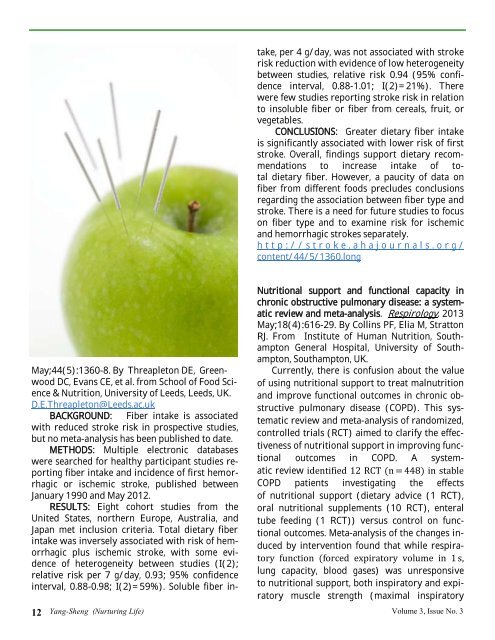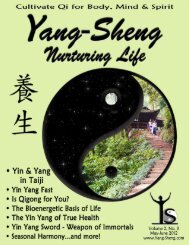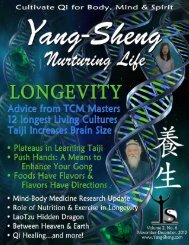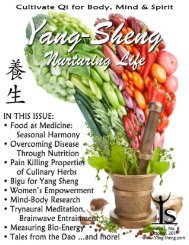May;44(5):1360-8. By Threaple<strong>to</strong>n DE, GreenwoodDC, Evans CE, et al. from School of Food Science& Nutrition, University of Leeds, Leeds, UK.D.E.Threaple<strong>to</strong>n@Leeds.ac.ukBACKGROUND: Fiber intake is <strong>as</strong>sociatedwith reduced stroke risk in prospective studies,but no meta-analysis h<strong>as</strong> been published <strong>to</strong> date.METHODS: Multiple electronic datab<strong>as</strong>eswere searched for healthy participant studies reportingfiber intake and incidence of first hemorrhagicor ischemic stroke, published betweenJanuary 1990 and May 2012.RESULTS: Eight cohort studies from theUnited States, northern Europe, Australia, andJapan met inclusion criteria. Total dietary fiberintake w<strong>as</strong> inversely <strong>as</strong>sociated with risk of hemorrhagicplus ischemic stroke, with some evidenceof heterogeneity between studies (I(2);relative risk per 7 g/day, 0.93; 95% confidenceinterval, 0.88-0.98; I(2)=59%). Soluble fiber intake,per 4 g/day, w<strong>as</strong> not <strong>as</strong>sociated with strokerisk reduction with evidence of low heterogeneitybetween studies, relative risk 0.94 (95% confidenceinterval, 0.88-1.01; I(2)=21%). Therewere few studies reporting stroke risk in relation<strong>to</strong> insoluble fiber or fiber from cereals, fruit, orvegetables.CONCLUSIONS: Greater dietary fiber intakeis significantly <strong>as</strong>sociated with lower risk of firststroke. Overall, findings support dietary recommendations<strong>to</strong> incre<strong>as</strong>e intake of <strong>to</strong>taldietary fiber. However, a paucity of data onfiber from different foods precludes conclusionsregarding the <strong>as</strong>sociation between fiber type andstroke. There is a need for future studies <strong>to</strong> focuson fiber type and <strong>to</strong> examine risk for ischemicand hemorrhagic strokes separately.h t t p : / / s t r o k e . a h a j o u r n a l s . o r g /content/44/5/1360.longNutritional support and functional capacity inchronic obstructive pulmonary dise<strong>as</strong>e: a systematicreview and meta-analysis. Respirology. 2013May;18(4):616-29. By Collins PF, Elia M, Strat<strong>to</strong>nRJ. From Institute of Human Nutrition, Southamp<strong>to</strong>nGeneral Hospital, University of Southamp<strong>to</strong>n,Southamp<strong>to</strong>n, UK.Currently, there is confusion about the valueof using nutritional support <strong>to</strong> treat malnutritionand improve functional outcomes in chronic obstructivepulmonary dise<strong>as</strong>e (COPD). This systematicreview and meta-analysis of randomized,controlled trials (RCT) aimed <strong>to</strong> clarify the effectivenessof nutritional support in improving functionaloutcomes in COPD. A systematicreview identified 12 RCT (n = 448) in stableCOPD patients investigating the effectsof nutritional support (dietary advice (1 RCT),oral nutritional supplements (10 RCT), enteraltube feeding (1 RCT)) versus control on functionaloutcomes. Meta-analysis of the changes inducedby intervention found that while respira<strong>to</strong>ryfunction (forced expira<strong>to</strong>ry volume in 1 s,lung capacity, blood g<strong>as</strong>es) w<strong>as</strong> unresponsive<strong>to</strong> nutritional support, both inspira<strong>to</strong>ry and expira<strong>to</strong>rymuscle strength (maximal inspira<strong>to</strong>ry12 <strong>Yang</strong>-<strong>Sheng</strong> (Nurturing Life) Volume 3, Issue No. 3
mouth pressure +3.86 standard error (SE) 1.89cm H2 O, P = 0.041; maximal expira<strong>to</strong>ry mouthpressure +11.85 SE 5.54 cm H2 O, P = 0.032) andhandgrip strength (+1.35 SE 0.69 kg, P = 0.05)were significantly improved and <strong>as</strong>sociated withweight gains of ≥2 kg. Nutritional supportproduced significant improvements in qualityof life in some trials, although meta-analysisw<strong>as</strong> not possible. It also led <strong>to</strong> improved exerciseperformance and enhancement of exercise rehabilitationprogrammes. This systematicreview and meta-analysis demonstratesthat nutritional support in COPD results in significantimprovements in a number of clinically relevantfunctional outcomes, complementing a previousreview showing improvements innutritionalintake and weight.Systematic review and meta-analysis of differentdietary approaches <strong>to</strong> the management of type2 diabetes. Am J Clin Nutr. 2013 Mar;97(3):505-16. By Ajala O, English P, Pinkney J. from Dept ofDiabetes and Endocrinology, Peninsula College ofMedicine and Dentistry, Plymouth, UK. olubukola.ajala@nhs.netBACKGROUND: There is evidence that reducingblood glucose concentrations, inducingweight loss, and improving the lipid profile reducescardiov<strong>as</strong>cular risk in people with type 2diabetes.OBJECTIVE: We <strong>as</strong>sessed the effect of variousdiets on glycemic control, lipids, and weight loss.DESIGN: We conducted searches of PubMed,Emb<strong>as</strong>e, and Google Scholar <strong>to</strong> August 2011. Weincluded randomized controlled trials (RCTs)with interventions that l<strong>as</strong>ted ≥6 mo that comparedlow-carbohydrate, vegetarian, vegan, lowglycemicindex (GI), high-fiber, Mediterranean,and high-protein diets with control diets includinglow-fat, high-GI, American Diabetes Association,European Association for the Study of Diabetes,and low-protein diets.RESULTS: A <strong>to</strong>tal of 20 RCTs were included(n = 3073 included in final analyses across 3460randomly <strong>as</strong>signed individuals). The lowcarbohydrate,low-GI, Mediterranean, and highproteindiets all led <strong>to</strong> a greater improvement inglycemic control [glycated hemoglobin reductionsof -0.12% (P = 0.04), -0.14% (P = 0.008), -0.47% (P < 0.00001), and -0.28% (P < 0.00001),respectively] compared with their respective controldiets, with the largest effect size seen in theMediterranean diet. Low-carbohydrate and Mediterraneandiets led <strong>to</strong> greater weight loss [-0.69kg (P = 0.21) and -1.84 kg (P < 0.00001), respectively],with an incre<strong>as</strong>e in HDL seen in all dietsexcept the high-protein diet.CONCLUSION: Low-carbohydrate, low-GI,Mediterranean, and high-protein diets are effectivein improving various markers of cardiov<strong>as</strong>cularrisk in people with diabetes and should beconsidered in the overall strategy of diabetesmanagement.http://ajcn.nutrition.org/content/97/3/505.longFat Intake After Diagnosis and Risk of Lethal ProstateCancer and All-Cause Mortality. JAMA InternMed. 2013 Jun 10:1-8. By Richman EL, KenfieldSA, Chavarro JE, et al.Nearly 2.5 million men currently live withprostate cancer in the United States, yet little isknown about the <strong>as</strong>sociation between diet afterdiagnosis and prostate cancer progression andoverall mortality.OBJECTIVE To examine postdiagnosticfat intake in relation <strong>to</strong> lethal prostate cancerand all-cause mortality.DESIGN AND PARTICIPANTS: Prospectivestudy of 4577 men with nonmet<strong>as</strong>tatic prostateJune-July 2013 <strong>Yang</strong>-<strong>Sheng</strong> (Nurturing Life) 13
- Page 1 and 2: Cover should go hereDraft for Comme
- Page 3 and 4: Volume 3, No. 3 www.Yang-Sheng.com
- Page 8 and 9: is to smile from the heart, mind, b
- Page 10 and 11: You’ll start with a pill for bloo
- Page 14 and 15: cancer in the Health Professionals
- Page 16 and 17: decrease in BMI of 8% was the thres
- Page 18 and 19: Ancient Wisdom, Modern Kitchen 古
- Page 20 and 21: From The Doctor 医 生 之 窗Rais
- Page 22 and 23: way, make your food come alive in t
- Page 24 and 25: Meditation in Motion 动 中 冥
- Page 26 and 27: try shows that “Chronic “lifest
- Page 28 and 29: far from ideal: “I estimate I spe
- Page 30 and 31: neered the concept of self-care by
- Page 32 and 33: Book Review 书 评Book Review: Hea
- Page 34 and 35: more awakened and real to you if yo
- Page 36 and 37: Daoist Internal Alchemy 道 家 内
- Page 38 and 39: Qi Cultivation and Dao 炼 气 与
- Page 40 and 41: etween physician and patient, betwe
- Page 42 and 43: neutralize, and transform unhealthy
- Page 44 and 45: make a difference in outcomes. Chap
- Page 46 and 47: dary Yang Cheng Fu, mentioned the f
- Page 48 and 49: the senior students, a disciple of
- Page 50 and 51: Scientific Qi Exploration 气 的
- Page 52 and 53: flexor carpi radialis muscles, endi
- Page 54 and 55: dial end of the popliteal crease (f
- Page 56 and 57: yourself.This year’s Building Bri
- Page 58 and 59: ¼ cup goji berries2-3 fresh mint l
- Page 60 and 61: from the plant's air channels. Lotu
- Page 62 and 63:
Yang-Sheng Needs Your Financial Sup













